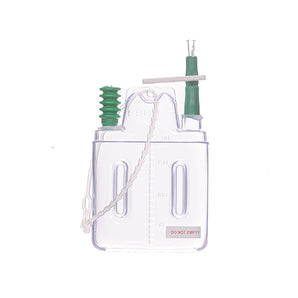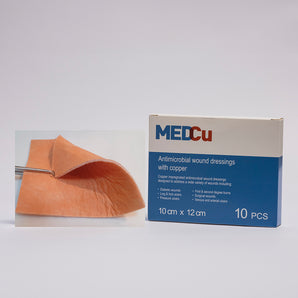Key Takeaways
- Hydrocolloid dressings create a moist wound environment, promoting tissue repair and protecting against bacteria and water.
- They effectively manage low to moderate wound exudate, making them suitable for conditions like pressure ulcers and post-surgical wounds.
- Benefits include reduced pain, extended wear time, waterproof protection, and improved patient comfort.
- Common hydrocolloid types include film-backed, foam-backed, and thin dressings, catering to diverse wound care needs.
- While highly effective, hydrocolloids are unsuitable for heavily exuding or infected wounds and may cause mild skin irritation in some cases.
- Hydrocolloids also have versatile uses beyond healthcare, including the food, cosmetics, and pharmaceutical industries.
Understanding how wounds heal is vital for anyone involved in healthcare, from hospitals to pharmacies. Hydrocolloid dressings play a key role in modern wound care by creating an optimal environment for healing. But what exactly do they do, and why are they so effective?
These dressings interact with wound exudate to form a cohesive gel, maintaining the moisture needed for tissue repair while protecting against bacteria and water. Their ability to manage low to moderate exudate makes them a reliable choice for various wound types, including pressure ulcers and post-surgical wounds. By reducing pain and staying in place for days, hydrocolloid dressings streamline care and improve patient comfort.
In this article, we’ll explore the science behind hydrocolloid dressings and their benefits, offering insights into why they’re a cornerstone of advanced wound care in both public and private healthcare settings.
Understanding Hydrocolloids
Hydrocolloids play a pivotal role in modern wound care by providing an optimal healing environment. They interact with wound exudate to form a gel-like substance that preserves moisture, protects against bacteria, and promotes tissue repair.
What Are Hydrocolloids?
Hydrocolloids are substances made from hydrophilic particles that absorb liquid and form a gel. They're commonly used in wound care as part of medical devices like hydrocolloid wound dressings. The dressings combine synthetic polymers and natural ingredients, such as pectin and gelatin. When applied, they react with wound exudate to create a moist protective layer that maintains skin integrity.
These dressings are impermeable to bacteria and water, enhancing protection while controlling exudate levels. We design our hydrocolloid wound dressings to meet advanced care standards, ensuring effective results across diverse medical settings.
Common Types Of Hydrocolloids
1. Film-backed hydrocolloids
These feature a polyurethane film backing, providing flexibility and waterproof protection. They're suitable for areas prone to movement or moisture exposure.
2. Foam-backed hydrocolloids
With foam backing, these dressings enhance exudate absorption while maintaining a moist wound environment for longer periods.
3. Thin hydrocolloids
Designed for superficial wounds or low-exudate cases, these lightweight dressings improve patient comfort and remain discreet on application.
Our carefully crafted hydrocolloid dressings combine performance and comfort, supporting healthcare providers across African markets in delivering effective wound care solutions.
Functions Of Hydrocolloids
Hydrocolloids perform essential functions in advanced wound care by creating protective, healing environments. Their unique interaction with wound exudate makes them a vital element in promoting effective recovery.
How Do Hydrocolloids Work?
Hydrocolloids, composed of hydrophilic particles, interact with wound exudate to form a cohesive gel. This gel retains moisture, ensuring an ideal healing environment. By maintaining skin integrity and creating a bacterial barrier, they reduce infection risks. Impermeable to water, they protect wounds during activities like bathing. Combining natural and synthetic polymers such as gelatin and pectin, hydrocolloids provide long-lasting coverage and minimise wound disturbance during dressing changes.
In low to moderate exudate wounds, hydrocolloid wound dressings absorb fluid efficiently, preventing maceration while promoting the natural healing process.
Benefits Of Hydrocolloid Usage
Hydrocolloids offer several benefits for wound management:
- Moist Wound Environment: Provides consistent moisture levels, aiding tissue regeneration.
- Exudate Management: Effectively handles low to moderate wound drainage without leakage.
- Bacterial Barrier: Protects against external contaminants and infections.
- Comfort & Pain Reduction: Cushions the wound and reduces pressure discomfort.
- Extended Wear Time: Can remain on wounds for multiple days, reducing frequent changes.
- Waterproof Protection: Allows flexibility for daily routines like showers.
- Adaptability: Suitable for pressure ulcers, venous leg ulcers, and post-surgical wounds.
These features make hydrocolloids an indispensable solution for effective wound care.
Applications Of Hydrocolloids
Hydrocolloids serve broad and diverse roles across multiple industries due to their unique properties. From wound care to food production, they deliver practical solutions suited to various needs.
Hydrocolloids In Medicine
Hydrocolloids play a critical role in modern healthcare. These compounds form the foundation of advanced wound care products like hydrocolloid wound dressings, which promote healing by maintaining a moist protective environment. At Dynamed Pharmaceuticals, we've designed our hydrocolloid wound dressing to provide superior exudate management while offering a bacterial and waterproof barrier.
These dressings are particularly effective for pressure ulcers, venous ulcers, and post-surgical wounds. By forming a gel upon contact with wound exudate, hydrocolloids facilitate healing and reduce discomfort. Additionally, their extended wear time reduces the frequency of dressing changes, enhancing both patient convenience and outcomes in clinical practice.
Hydrocolloids In Food Industry
In the food industry, hydrocolloids ensure texture stability and improve shelf life. These substances act as thickeners, stabilisers, or gelling agents in products like sauces, dairy, and baked goods. For instance, pectin and gelatin—two common hydrocolloids—are used to create jams and jelly-like textures. They also work as emulsifiers in beverages and low-fat alternatives, ensuring a uniform product structure.
Their moisture-retaining capabilities enhance the eating experience, keeping items like bread softer for longer. Additionally, hydrocolloids aid in reducing food waste by improving spoilage resistance, making them valuable for both consumers and manufacturers.
Other Uses Of Hydrocolloids
Beyond healthcare and food, hydrocolloids find applications in other areas. They're used in cosmetics for anti-ageing products, where their moisture retention supports skin hydration. In the pharmaceutical industry, they appear in capsule coatings and controlled-release drugs. Even specialty industries like textiles and paper manufacturing benefit from the adhesive and binding properties of hydrocolloids.
Hydrocolloids remain versatile across these sectors, offering solutions that enhance product performance and meet diverse consumer needs. These unique capabilities highlight their critical contributions in advanced wound care, consumables, and beyond.
Potential Limitations Of Hydrocolloids
Hydrocolloid wound dressings are highly effective, but there are certain limitations worth understanding to ensure their appropriate application in wound care. These considerations are crucial when assessing whether hydrocolloids align with a patient’s specific needs.
Misconceptions About Hydrocolloids
One common misconception is that hydrocolloid wound dressings suit all wound types. While they provide excellent results for low to moderate exudate levels, they may not effectively manage heavily exuding wounds or infected wounds. Understanding the scope of hydrocolloids ensures they are applied correctly, reducing risks of improper management.
The idea that hydrocolloids require frequent changes is another misconception. In reality, they are designed for extended wear, staying in place for several days depending on wound exudate levels. Misunderstanding this feature can lead to unnecessary dressing changes, which may disrupt the healing process.
Challenges In Hydrocolloid Usage
Skin sensitivity challenges occur in some patients, as prolonged use may cause mild irritation or maceration if exudate accumulates beyond the dressing’s capacity. This highlights the potential need for alternative dressings or monitoring in sensitive cases.
Removing hydrocolloids can sometimes be uncomfortable, particularly if the dressing adheres strongly to surrounding skin. Applying the dressing with care and using proper removal techniques can minimise discomfort and skin trauma during changes.
Using hydrocolloid dressings under certain conditions, such as in the presence of infection, limits their effectiveness. They are not suitable when bacterial management requires antimicrobial solutions. Healthcare professionals must evaluate the wound status to determine if hydrocolloids are the optimal choice for treatment.
In highly humid climates or near intensive activity zones, maintaining the integrity of hydrocolloid dressings can pose challenges. Waterproof features of such dressings help, but mechanical abrasion due to movement or persistent moisture may still compromise adhesion.
Conclusion
Hydrocolloids have revolutionised wound care and extended their impact across diverse industries. Their unique ability to create a protective, moisture-rich environment makes them invaluable for promoting healing, enhancing comfort, and delivering reliable results. By understanding their functionality and limitations, we can ensure their optimal use in both medical and non-medical applications. As we continue to explore their potential, hydrocolloids remain a cornerstone of innovation and effectiveness in modern care solutions.
Visit Dynamed Pharmaceuticals
Phone: 0861 00 00 43
Website: dynamed.co.za
Email (Sales): sales@dynamed.co.za
Email (Info): info@dynamed.co.za
Google Maps: Find us here
Frequently Asked Questions
What are hydrocolloid dressings used for in wound care?
Hydrocolloid dressings are used to create a moist healing environment, manage wound exudate, and protect wounds from bacteria. They are effective for wounds like pressure ulcers, post-surgical wounds, and minor injuries, promoting faster healing and reducing pain.
How do hydrocolloid dressings work?
These dressings interact with wound exudate to form a gel that maintains moisture and creates a protective barrier. They absorb fluids, protect against bacteria, and help keep wounds clean while also providing comfort and allowing for extended wear.
Are hydrocolloid dressings waterproof?
Yes, hydrocolloid dressings are waterproof. They protect wounds from water during activities like bathing, ensuring the wound remains undisturbed and free from external contaminants.
What types of hydrocolloid dressings are available?
Common types include film-backed, foam-backed, and thin hydrocolloids. Each type is designed for specific wound care needs, providing tailored solutions based on factors like exudate levels and wound size.
What are the benefits of using hydrocolloid dressings?
Hydrocolloid dressings maintain moisture, manage exudate, provide a bacterial barrier, minimise pain, enhance comfort, and allow for long wear times. Their waterproof and protective nature makes them ideal for advanced wound care.
Are hydrocolloid dressings suitable for all wound types?
No, they are not recommended for heavily exuding or infected wounds. Healthcare professionals should evaluate the wound type before using hydrocolloid dressings to ensure appropriate treatment.
Can hydrocolloid dressings cause skin irritation?
While generally safe, some individuals may experience skin sensitivity or irritation. Proper application and monitoring can help minimise any adverse reactions during use.
How often should hydrocolloid dressings be changed?
Hydrocolloid dressings are designed for extended wear, typically up to 5-7 days, depending on the level of exudate. Frequent changes are not required unless the dressing becomes saturated or dislodged.
What industries use hydrocolloids besides healthcare?
Beyond wound care, hydrocolloids are used in the food industry as thickeners and stabilisers, in cosmetics for texture, and in pharmaceuticals for controlled release, showcasing their versatility across industries.
Do hydrocolloid dressings protect against infection?
Yes, hydrocolloid dressings form a barrier against bacteria, reducing the risk of infection. However, they should not be used on already infected wounds without proper medical supervision.






